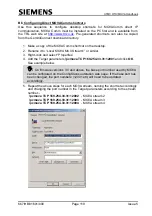
UTMC OTU/MOVA Handbook
667/HB/31601/000
Page 105
Issue 5
7.7 CONFIGURATION OF MOVA WITH UTC
The junction can be operated with either UTC or MOVA as the normal mode of control.
This is achieved by the UTC MO control bit which allows MOVA to be brought on-
control in preference to UTC – see section 7.7.5.
If UTC is unavailable e.g. because of network fail or UTC instation fail, then MOVA will
take control.
Since UTC and MOVA both control the junction using F-bits, the most efficient
configuration is for UTC and MOVA to use the same control and reply bit definitions.
7.7.1 Demand-Dependent Forces
F-bits which are demand dependent under UTC need to be modified under MOVA so
that they are effectively not demand dependent. This can be achieved by controller
special conditioning to activate the demand when MOVA is in control and the F-bit is
activated.
7.7.2 Green Confirms
Both MOVA and UTC can have the same stage green confirms, but MOVA will require
extra phase green confirms where there are phase overlaps. These extra confirms
would normally be configured after the stage confirms. The extra confirms should be
configured in the UTC database so that they can be monitored and checked even
though they are not required for UTC SCOOT control.
7.7.3 Detector Inputs – MOVA 6
For the semi-integral OTU, there is a maximum of 64 detectors available from the
controller across the serial link. These are shared between MOVA and SCOOT.
It is recommended that the SCOOT detectors are allocated from detector 64 downward.
This allows MOVA detectors to be allocated from detector 1 upward.
7.7.4 Detector Inputs – MOVA 7
For MOVA 7 the number of available detectors has been extended to 128
Detectors can be defined globally across all streams as per MOVA 6 which will limit the
total to 64, or on a per stream basis. In the per stream method a separate site is
required for each stream (eg. MOVA1, MOVA2…) and the config function chosen from
MOVA1DETn, MOVA2DETn, MOVA3DETn or MOVA4DETn according to the stream –
see Appendix G.






























